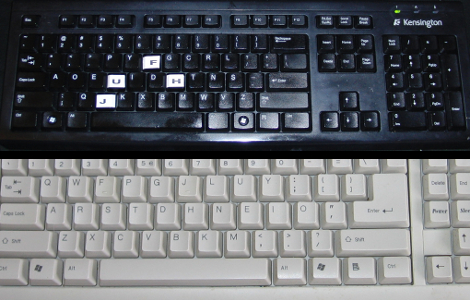
[BiOzZ] wanted to try a different keyboard layout than the ubiquitous Qwerty, so he grabbed an old keyboard and converted it to the Dvorak setup. This was accomplished by first popping off all of the keys from the black keyboard seen above, and boy did he find a mess underneath. It was nothing that a trip through the dishwasher (for the case only) wouldn’t fix, and the next step was to replace the keys in a different order. He found that a couple of them wouldn’t just go back in a different place, but had to be rotated 90 degrees to fit. Not a huge problem, you can see that he overcame the visual speedbump of letters facing the wrong way by adding his own letter labels. From there he walks us through the process of getting Windows to switch to the Dvorak layout.
I went through a similar process at the end of last year. I was experiencing a lot of pain in my hands from my prolific feature writing here at Hackaday so I chose to try out the Colemak keyboard. The white keyboard above is the one I repurposed using that layout. I found it quite easy to switch between two keyboard layouts using Ubuntu. After you’ve set it up in the keyboards dialog a layout icon appears on the panel. It wasn’t hard to pick the new key locations up, but it did reduce my typing speed by a factor of 8. In the end I found that adjusting my chair height and keeping my hands warm did the trick and I’m back on the Qwerty where I belong.















I think a good idea would be to do this with a standard cell phone (not a phone with a full keyboard but a phone with the T9 style keyboard) perhaps you could mix the keys up so instead of typing 1 twice to get a B it might be a Z
With Windows you can activate multiple layouts and switch back and forth with ctrl-shift, so for me there was no real need to rearrange the keys on my keyboard; I found a site that had Dvorak drills on it, and practiced those for a few minutes every night until I felt comfortable enough with the layout to practice a little bit at work too.
Eventually I came to a point where my QWERTY typing speed was beginning to suffer and Dvorak felt more natural, and took that as the signal to make the switch for good.
I’d been touch-typing with QWERTY for about 8 years, and my typing speed after only a year with Dvorak has already exceeded what I was capable of with QWERTY. Definitely worth the switch, and there’s no need to do anything silly with your physical keyboard.